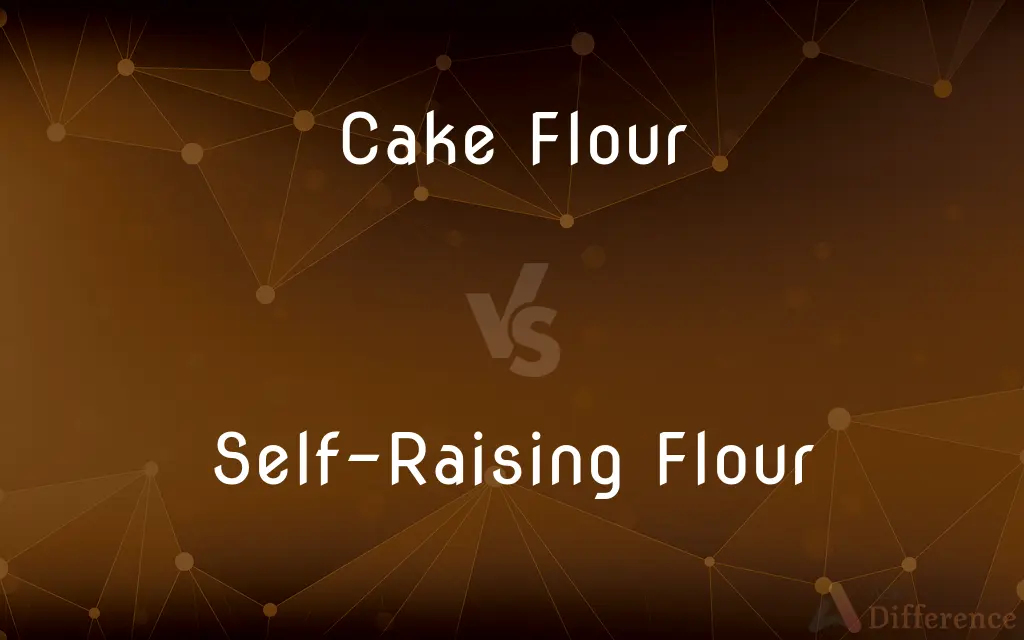Cake Flour vs. Self-Raising Flour — What's the Difference?
By Tayyaba Rehman & Urooj Arif — Published on October 30, 2024
Cake flour is finely milled and low in protein, ideal for tender baked goods, whereas self-raising flour contains leavening agents for automatic rising.

Difference Between Cake Flour and Self-Raising Flour
Table of Contents
ADVERTISEMENT
Key Differences
Cake flour is known for its fine, soft texture and low protein content, typically around 7-9%. This makes it ideal for producing light and airy cakes with a fine crumb. Its low protein level reduces the formation of gluten, which is crucial for tender baked goods. On the other hand, self-raising flour is a convenience product that combines all-purpose flour, a leavening agent (usually baking powder), and sometimes a little salt. The protein content of self-raising flour is usually similar to that of all-purpose flour, around 9-11%.
Cake flour often requires the addition of a leavening agent, such as baking powder or baking soda, to help the cake rise. Self-raising flour is designed to make baking simpler by eliminating the need for separate leavening agents. It's suitable for recipes specifically designed for self-raising flour, like certain cakes, biscuits, and quick breads.
While cake flour is specifically designed to produce tender and fine-textured cakes, self-raising flour offers versatility and convenience for various baked goods. It's important to use them in their intended recipes to achieve the desired texture and rise.
Although both types of flour are used in baking, they serve different purposes and are not directly interchangeable without adjustments to the recipe. For example, when substituting cake flour for self-raising flour, you'll need to add a leavening agent. Conversely, if using self-raising flour instead of cake flour, adjustments to leavening agents in the recipe are necessary.
Understanding the specific role of each flour can help bakers choose the right one for their recipe, ensuring the best possible texture and rise of their baked goods. Both cake flour and self-raising flour are staples in the pantry of home bakers and professionals alike, each bringing its unique properties to a variety of recipes.
ADVERTISEMENT
Comparison Chart
Protein Content
Low (7-9%)
Medium (9-11%)
Leavening Agents
None
Pre-mixed (usually baking powder)
Texture
Fine, soft
Slightly coarser than cake flour
Best Used For
Tender, fine-crumbed cakes
Recipes needing rise without additional leaveners
Adjustment in Recipes
Requires leavening agent
Leavening agent adjustments needed if substituted
Compare with Definitions
Cake Flour
Not interchangeable with self-raising flour without adjustments.
If substituting cake flour for self-raising flour, don't forget to adjust the leavening agents.
Self-Raising Flour
Suitable for recipes designed for its specific blend.
Use self-raising flour for quick and easy pancakes without the fuss.
Cake Flour
Requires a leavening agent for rising.
Remember to add baking powder to your cake flour for the cake to rise.
Self-Raising Flour
Requires adjustments when used as a substitute for other flours.
If using self-raising flour instead of all-purpose, reduce the added leavening.
Cake Flour
Ideal for delicate baked goods.
Cake flour makes the perfect base for tender cupcakes.
Self-Raising Flour
Can make baking simpler by eliminating the need for separate leavening agents.
Self-raising flour is great for beginner bakers due to its convenience.
Cake Flour
Produces a fine crumb texture.
Cake flour is the secret to that incredibly soft crumb.
Self-Raising Flour
Flour that includes a leavening agent, usually baking powder, and sometimes salt.
Self-raising flour simplifies biscuit recipes by including the leavener.
Cake Flour
A fine, soft flour with a low protein content, used for making cakes.
For a light and fluffy sponge cake, always use cake flour.
Self-Raising Flour
Not ideal for very tender cakes like those made with cake flour.
For a finer texture, opt for cake flour over self-raising flour in delicate recipes.
Common Curiosities
What is cake flour best used for?
Cake flour is best used for delicate baked goods like cakes, cupcakes, and certain pastries that benefit from a tender, fine crumb.
Can self-raising flour be used for all baking recipes?
Self-raising flour is best used for recipes specifically designed for it, as it contains pre-added leavening agents.
Is cake flour the same as all-purpose flour?
No, cake flour has a lower protein content and a finer texture, making it different from all-purpose flour, which is more versatile.
Do I need to add baking powder to cake flour?
Yes, if the recipe requires leavening, you need to add a leavening agent like baking powder or baking soda to cake flour.
Is cake flour good for bread?
No, cake flour's low protein content isn't ideal for bread, which requires higher protein flour for structure and chew.
What can I use if I don't have self-raising flour?
You can make a substitute by adding baking powder and a little salt to all-purpose flour.
How do I make my own cake flour?
You can make cake flour by subtracting some all-purpose flour and adding cornstarch to lower the protein content and mimic its fine texture.
Can I substitute self-raising flour for cake flour?
Yes, but you'll need to adjust the leavening agents in the recipe since self-raising flour already contains baking powder.
Can I use self-raising flour for cookies?
Yes, self-raising flour can be used for cookies, especially if you're looking for an easy recipe with minimal ingredients.
Does cake flour make a difference in cake recipes?
Yes, cake flour can significantly affect the texture of cakes, making them lighter and more tender.
How do I store cake flour and self-raising flour?
Both should be stored in a cool, dry place. Sealing them airtight can extend their shelf life.
Is there a gluten-free version of cake flour or self-raising flour?
Yes, there are gluten-free versions of both, designed to mimic their properties without gluten.
What's the difference in texture between cakes made with cake flour and self-raising flour?
Cakes made with cake flour tend to have a finer, softer crumb, while those made with self-raising flour might be slightly coarser but still soft.
How does the protein content affect baking?
Protein content affects the formation of gluten, with higher protein flours creating tougher baked goods, while lower protein flours create tender textures.
Why is my cake dense when using self-raising flour?
Your cake may be dense due to overmixing or not enough leavening agent relative to the weight of other ingredients.
Share Your Discovery

Previous Comparison
Virtualbox vs. VMware
Next Comparison
Diesel Oil vs. Gas OilAuthor Spotlight
Written by
Tayyaba RehmanTayyaba Rehman is a distinguished writer, currently serving as a primary contributor to askdifference.com. As a researcher in semantics and etymology, Tayyaba's passion for the complexity of languages and their distinctions has found a perfect home on the platform. Tayyaba delves into the intricacies of language, distinguishing between commonly confused words and phrases, thereby providing clarity for readers worldwide.
Co-written by
Urooj ArifUrooj is a skilled content writer at Ask Difference, known for her exceptional ability to simplify complex topics into engaging and informative content. With a passion for research and a flair for clear, concise writing, she consistently delivers articles that resonate with our diverse audience.













































